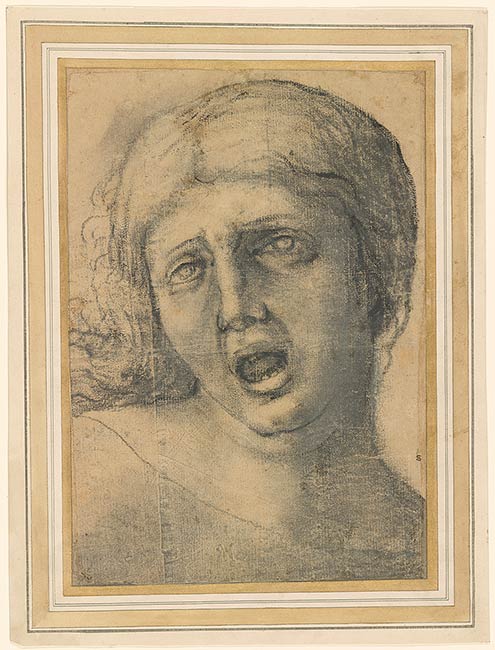
Correggio was renowned for his technical virtuosity, the vivid coloring of his paintings, and the intensely dramatic expressions of his figures. He proved a major influence not only on his pupil Parmigianino but also on artists of later generations such as the Carracci. His most important works include frescoes painted during the 1520s in Parma Cathedral and in San Giovanni Evangelista, Parma. Though his early years remain difficult to reconstruct, his artistic beginnings betray the influence of Andrea Mantegna, whose works he saw in Mantua in the 1510s.
Two frescoed roundels depicting the Entombment and the Holy Family with SS. Elizabeth and John the Baptist from the west portico of the basilica of Sant’Andrea in Mantua—now detached and in the Museo Diocesano of that same city—may represent Correggio’s earliest surviving works.1 Ippolito Donesmondi, in his Dell’istoria ecclesiastica di Mantova, published in 1612–16, attributes them to Correggio together with the four Evangelists depicted in Mantegna’s funerary chapel, also located in Sant’Andrea.2 The murals may have been painted as early as 1510, thus predating Correggio’s first securely documented work, the Madonna of St. Francis (now in the Gemäldegalerie, Dresden), for which a contract was signed in 1514.3 Though badly damaged, the Mantua frescoes reveal a profound understanding of the dark pathos of the late style of Mantegna, from whom the facial type, classical monumentality, and expressive force are derived.
Remarkable for its intensity of emotion, the present drawing is a cartoon for the head of the grief-stricken Mary Magdalene in the Entombment, as was first recognized by A. E. Popham in 1957. Its soft, sfumato-like modeling may reflect some early contact with the work of Leonardo, to whom the drawing was attributed in the nineteenth century. The charcoal is applied heavily, accentuating the eyes, eyebrows, and hair on the side of the head that lies in shadow. The sinopia, or fresco underdrawing, which came to light when the mural was removed from its original location in the early 1960s, reveals that the artist closely followed the design of the present drawing. Unusually detailed, the cartoon indicates that even at a young age the artist understood the importance of planning the composition carefully before beginning to paint, since the fresco technique does not allow for alterations once the plaster has dried.
The only other known cartoon by Correggio, also a fragment, is a black chalk head of an angel at the École des Beaux-Arts, Paris, which is related to the frescoes in Parma Cathedral.4
—REP
Footnotes:
- For the Holy Family, see Ekserdjian 1997, 26.
- Donesmondi 1612–16, 49.
- Ekserdjian 1997.
- École des Beaux-Arts, Paris, inv. 109. See Popham 1957, pl. 84.
Watermark: None visible through lining.
Fragment of the cartoon for the fresco tondo Christ's Entombment, portico of S. Andrea, Mantua.
Formerly attributed to Ercole de' Roberti and to Anonymous, Italian School, 16th century.
Inscribed on verso of old mount at upper center, in pen and brown ink, "M / No.[o superscript] 1"; in graphite, "lot 806. / v i / S D; gen(?) Sebastiano del Piombo", in pen and brown ink, "L..." (cut off by edge of sheet).
Anonymous, Italian School, 16th cent., Formerly attributed to.
Roberti, Ercole de', -1496, Formerly attributed to.
Haym, Nicola Francesco, former owner.
Spencer, Earl, former owner.
Alexander, William, 1767-1816, former owner.
Murray, Charles Fairfax, 1849-1919, former owner.
Morgan, J. Pierpont (John Pierpont), 1837-1913, former owner.
Morgan, J. P. (John Pierpont), 1867-1943, former owner.
Rhoda Eitel-Porter and and John Marciari, Italian Renaissance Drawings at the Morgan Library & Museum, New York, 2019, no. 73.
Selected references: Fairfax Murray 1905-12, 4: no. 30 (as Lombard school); Parker 1927, no. 27 (as Ercole de' Roberti); Ortolani 1941, 202-3; Tietze 1947, no. 15 (as Ferrarese school); Popham 1957, no. 1; Zamboni 1958, 191; New York 1959, no. 14; Bean 1960, 168; Hartford 1960, no. 68; Bottari 1961, 10; Ames 1962, no. 265; Ames 1963, 104, 132; New York 1965-66, no. 65; Quintavalle 1970, under 13B; Pelati 1974, 7-8; Gould 1976, 283; Brown 1977, 861; New York 1981, no. 17; Washington and Parma 1984, no. 1; De Marchi 1986, 28; Di Giampaolo and Muzzi 1989, no. 1; Ekserdjian 1997, 26; London and New York 2000-2001, no. 1; New York 2006, no. 13; Paris 2008, no. 196; Rennes 2015, under no. 22.
Collection J. Pierpont Morgan : Drawings by the Old Masters Formed by C. Fairfax Murray. London : Privately printed, 1905-1912, IV, 30, repr.
Stampfle, Felice, and Jacob Bean. Drawings from New York collections. I: The Italian Renaissance. New York : Metropolitan Museum of Art : Pierpont Morgan Library, 1965, p. 48, no. 65, repr.
European drawings, 1375-1825 / catalogue compiled by Cara D. Denison & Helen B. Mules ; with the assistance of Jane V. Shoaf. New York : Pierpont Morgan Library ; Oxford : Oxford University Press, 1981, p. 44, no. 17.
From Leonardo to Pollock: Master drawings from the Morgan Library. New York: Morgan Library, 2006, cat. no. 13, p. 30-31.
